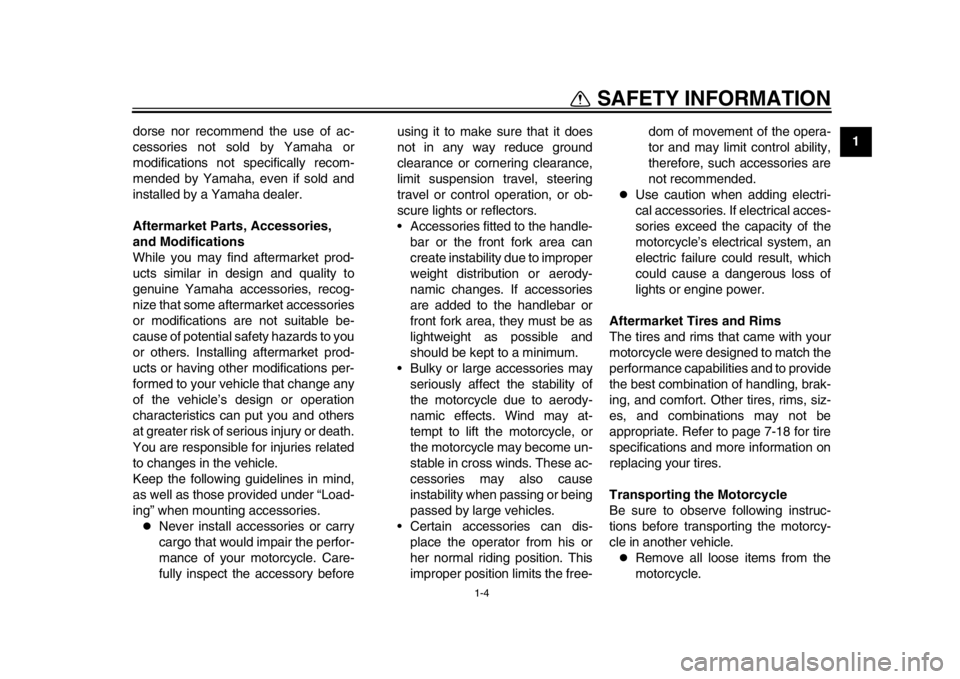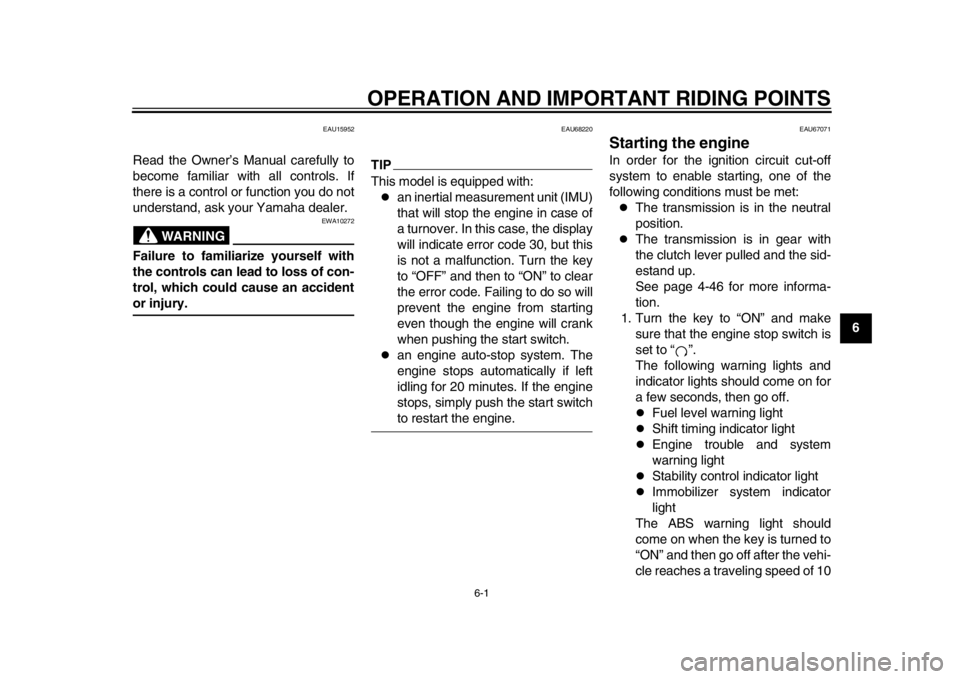lights YAMAHA YZF-R1M 2015 Owners Manual
[x] Cancel search | Manufacturer: YAMAHA, Model Year: 2015, Model line: YZF-R1M, Model: YAMAHA YZF-R1M 2015Pages: 126, PDF Size: 9.02 MB
Page 6 of 126

TABLE OF CONTENTSSAFETY INFORMATION................... 1-1
DESCRIPTION ................................... 2-1
Left view .......................................... 2-1
Right view ........................................ 2-2
Controls and instrument s................. 2-3
SPECIAL FEATURES ........................ 3-1
YRC (Yamaha Ride Control) ........... 3-1
Glossary .......................................... 3-3
YRC functions visual guide.............. 3-4
INSTRUMENT AND CONTROL
FUNCTIONS ....................................... 4-1
Immobilizer system ....... ................... 4-1
Main switch/steering lock................. 4-2
Handlebar switches ......................... 4-3
Indicator lights and warning lights ... 4-6
Display ............................................. 4-8
MENU screen ................................ 4-14
Clutch lever.................................... 4-29
Shift pedal....... ............................. .. 4-30
Brake lever .................................... 4-30
Brake pedal ................................... 4-31
Brake system ..... ............................ 4-31
Fuel tank cap ................................. 4-33
Fuel................................................ 4-33
Fuel tank breather hose and overflow hose ............................. 4-35
Catalytic converter ......................... 4-35
Seats ............................................. 4-36 CCU (for equipped models) .......... 4-37
Document storage ......................... 4-38
Rear view mirrors .......................... 4-39
Adjusting the front fork .................. 4-39
Adjusting the shock absorber
assembly.................................... 4-41
EXUP system ................................ 4-45
Sidestand ...................................... 4-45
Ignition circuit cut- off system ......... 4-46
Auxiliary DC connector.................. 4-48
FOR YOUR SAFETY –
PRE-OPERATION CHECKS ............. 5-1
OPERATION AND IMPORTANT
RIDING POINTS ................................. 6-1
Starting the engine .......................... 6-1
Shifting ............................................ 6-2
Tips for reducing fuel consumption ................................ 6-4
Engine break-in ............................... 6-4
Parking ............................................ 6-5
PERIODIC MAINTENANCE AND
ADJUSTMENT ................................... 7-1
Owner’s tool kit................................ 7-2
Periodic maintenance chart for the emission control system .............. 7-3
General maintenance and lubrication chart ........................... 7-4 Removing and installing cowlings
and panels .................................... 7-8
Checking the spark plugs .............. 7-11
Engine oil and oil filt er cartridge..... 7-12
Coolant .......................................... 7-14
Air filter element ............................. 7-17
Checking the engine idling speed............ ............................ .. 7-17
Checking the throttle grip free play ............................................. 7-18
Valve clearance ............................. 7-18
Tires ............................................... 7-18
Cast magnesium wheels ................ 7-21
Adjusting the clutch lever free
play ............................................. 7-22
Checking the brake lever free play ............................................. 7-22
Brake light switches ....................... 7-23
Checking the front and rear brake pads............................................ 7-23
Checking the brake fluid level ........ 7-24
Changing the brake fluid ................ 7-25
Drive chain slack............................ 7-25
Cleaning and lubricating the drive chain ........................................... 7-27
Checking and lubricating the cables ......................................... 7-27
Checking and lubricating the
throttle grip and cable ................. 7-28
Checking and lubricating the brake and shift pedals ................ 7-282CR-9-E0_1.book 1 ページ 2015年1月5日 月曜日 午前11時54分
Page 7 of 126

TABLE OF CONTENTS
Checking and lubricating the brake and clutch levers .............. 7-29
Checking and lubricating the sidestand.................................... 7-29
Lubricating the swingarm pivots .... 7-30
Checking the front fork .................. 7-30
Checking the steering.................... 7-31
Checking the wheel bearings ........ 7-31
Battery ........................................... 7-31
Replacing the fuses ....................... 7-33
Vehicle lights ................................. 7-35
Supporting the motor cycle ............. 7-36
Troubleshooting............................. 7-36
Troubleshooting charts .................. 7-37
MOTORCYCLE CARE AND
STORAGE .......................................... 8-1
Matte color caution .......................... 8-1
Care................................................. 8-1
Storage ............................................ 8-4
SPECIFICATIONS .............................. 9-1
CONSUMER INFORMATION ........... 10-1
Identification numbers ................... 10-1
INDEX ............................................... 11-1
2CR-9-E0_1.book 2 ページ 2015年1月5日 月曜日 午前11時54分
Page 11 of 126

SAFETY INFORMATION
1-4
12
3
4
5
6
7
8
9
10
11
12
dorse nor recommend the use of ac-
cessories not sold by Yamaha or
modifications not specifically recom-
mended by Yamaha, even if sold and
installed by a Yamaha dealer.
Aftermarket Parts, Accessories,
and Modifications
While you may find aftermarket prod-
ucts similar in design and quality to
genuine Yamaha accessories, recog-
nize that some aftermarket accessories
or modifications are not suitable be-
cause of potential safety hazards to you
or others. Installing aftermarket prod-
ucts or having other modifications per-
formed to your vehicle that change any
of the vehicle’s design or operation
characteristics can put you and others
at greater risk of serious injury or death.
You are responsible for injuries related
to changes in the vehicle.
Keep the following guidelines in mind,
as well as those provided under “Load-
ing” when mounting accessories.
Never install accessories or carry
cargo that would impair the perfor-
mance of your motorcycle. Care-
fully inspect the accessory before using it to make sure that it does
not in any way reduce ground
clearance or cornering clearance,
limit suspension travel, steering
travel or control operation, or ob-
scure lights or reflectors.
Accessories fitted to the handle-
bar or the front fork area can
create instability due to improper
weight distribution or aerody-
namic changes. If accessories
are added to the handlebar or
front fork area, they must be as
lightweight as possible and
should be kept to a minimum.
Bulky or large accessories may seriously affect the stability of
the motorcycle due to aerody-
namic effects. Wind may at-
tempt to lift the motorcycle, or
the motorcycle may become un-
stable in cross winds. These ac-
cessories may also cause
instability when passing or being
passed by large vehicles.
Certain accessories can dis- place the operator from his or
her normal riding position. This
improper position limits the free- dom of movement of the opera-
tor and may limit control ability,
therefore, such accessories are
not recommended.
Use caution when adding electri-
cal accessories. If electrical acces-
sories exceed the capacity of the
motorcycle’s electrical system, an
electric failure could result, which
could cause a dangerous loss of
lights or engine power.
Aftermarket Tires and Rims
The tires and rims that came with your
motorcycle were designed to match the
performance capabilities and to provide
the best combination of handling, brak-
ing, and comfort. Other tires, rims, siz-
es, and combinations may not be
appropriate. Refer to page 7-18 for tire
specifications and more information on
replacing your tires.
Transporting the Motorcycle
Be sure to observe following instruc-
tions before transporting the motorcy-
cle in another vehicle.
Remove all loose items from the
motorcycle.
2CR-9-E0_1.book 4 ページ 2015年1月5日 月曜日 午前11時54分
Page 21 of 126

INSTRUMENT AND CONTROL FUNCTIONS
4-2
1
2
345
6
7
8
9
10
11
12
ference.
EAU10474
Main switch/steering lockThe main switch/steering lock controls
the ignition and lighting systems, and is
used to lock the steering. The various
positions are described below.TIPBe sure to use the standard key (black
bow) for regular use of the vehicle. To
minimize the risk of losing the code
re-registering key (red bow), keep it in a
safe place and only use it for codere-registering.
EAU10551
ON
All electrical circuits are supplied with
power, the meter lighting, taillight, li- cense plate light and auxiliary lights
come on, and the engine can be start-
ed. The key cannot be removed.
TIPThe headlights come on automatically
when the engine is started and stay on
until the key is turned to “OFF”, even ifthe engine stalls.
EAU10662
OFF
All electrical syst
ems are off. The key
can be removed.
WARNING
EWA10062
Never turn the key to “OFF” or
“LOCK” while the vehicle is moving.
Otherwise the electrical systems will
be switched off, which may result inloss of control or an accident.
EAU10685
LOCK
The steering is locked, and all electrical
systems are off. The key can be re-
moved.
P
ON
OFF
LOCK
2CR-9-E0_1.book 2 ページ 2015年1月5日 月曜日 午前11時54分
Page 22 of 126

INSTRUMENT AND CONTROL FUNCTIONS
4-3
1
2
34
5
6
7
8
9
10
11
12 To lock the steering
1. Turn the handlebars all the way to
the left.
2. Push the key in from the “OFF” po- sition, and then turn it to “LOCK”
while still pushing it.
3. Remove the key. To unlock the steering
Push the key in, and then turn it to
“OFF” while still pushing it.
EAU65680
(Parking)
The hazard lights can be turned on, but
all other electrical systems are off. The
key can be removed.
The steering must be locked before the
key can be turned to “ ”.NOTICE
ECA22330
Using the hazard lights for an ex-
tended length of time may cause thebattery to discharge.
EAU66050
Handlebar switchesLeft
1. Push.
2. Turn.12
1. Push.
2. Turn.12
1. Pass/LAP switch “ /LAP”
2. Dimmer switch “ / ”
3. Hazard switch “ ”
4. Horn switch “ ”
5. Turn signal switch “ / ”
12
543
2CR-9-E0_1.book 3 ページ 2015年1月5日 月曜日 午前11時54分
Page 23 of 126

INSTRUMENT AND CONTROL FUNCTIONS
4-4
1
2
345
6
7
8
9
10
11
12
Right
EAU66091
Pass/LAP switch “ /LAP”
Press this switch to flash the headlights
and to mark the start of each lap when
using the lap timer.
EAU66020
Dimmer switch “ / ”
Set this switch to “ ” for the high
beam and to “ ” for the low beam.
EAU66040
Turn signal switch “ / ”
To signal a right-hand turn, push this
switch to “ ”. To signal a left-hand
turn, push this switch to “ ”. When re-
leased, the switch returns to the center
position. To cancel the turn signal
lights, push the switch in after it has re-
turned to the center position.
EAU66030
Horn switch “ ”
Press this switch to sound the horn.
EAU66060
Stop/Run/Start switch “ / / ”
To crank the engine with the starter, set
this switch to “ ”, and then push the
switch down towards “ ”. See page 6-1 for starting instructions prior to
starting the engine.
Set this switch to “ ” to stop the engine
in case of an emergency, such as when
the vehicle overturns or when the throt-
tle cable is stuck.
EAU67360
The engine trouble and system warning
light and ABS warning light may come
on when the key is turned to “ON” and
the start switch is pushed, but this does
not indicate a malfunction.
EAU66010
Hazard switch “ ”
With the key in the “ON” or “ ” posi-
tion, use this switch to turn on the haz-
ard lights (simultaneous flashing of all
turn signal lights).
The hazard lights are used in case of
an emergency or to warn other drivers
when your vehicle is stopped where it
might be a traffic hazard.NOTICE
ECA10062
Do not use the hazard lights for an
extended length of time with the en-
1. Mode switch “MODE”
2. Up button
3. Center button
4. Down button
1. Stop/Run/Start switch “ / / ”
2. Wheel switch “ ”1
2
4 31
2
2CR-9-E0_1.book 4 ページ 2015年1月5日 月曜日 午前11時54分
Page 25 of 126

INSTRUMENT AND CONTROL FUNCTIONS
4-6
1
2
345
6
7
8
9
10
11
12
EAU49398
Indicator lights and warning
lights
EAU11022
Turn signal indicator light “ ”
This indicator light flashes when a turn
signal light is flashing.
EAU11061
Neutral indicator light “ ”
This indicator light comes on when the
transmission is in the neutral position.
EAU11081
High beam indicator light “ ”
This indicator light comes on when the
high beam of the headlight is switched
on.
EAU66890
Fuel level warning light “ ”
This warning light comes on when the
fuel level drops below approximately
3.0 L (0.79 US gal, 0.66 Imp.gal). When
this occurs, refuel as soon as possible.
The electrical circuit of the warning light
can be checked by turning the key to
“ON”. The warning light should come
on for a few seconds and then go off.TIPIf the warning light does not come on at
all, remains on after refueling, or if the
warning light flashes repeatedly, havea Yamaha dealer check the vehicle.
EAU66501
ABS warning light “ ”
In normal operation, the ABS warning
light comes on when the key is turned
to “ON”, and goes off after traveling at a
speed of 10 km/h (6 mi/h) or higher.
If the warning light does not work as de-
scribed above, or if the warning light
comes on while riding, the ABS and
UBS may not work correctly. Have a
Yamaha dealer check the vehicle as
soon as possible. (See “Brake system”
on page 4-31 for an explanation of ABS
and UBS.)
WARNING
EWA16041
If the ABS warning light does not go
off after traveling at a speed of 10
km/h (6 mi/h) or higher, or if the
warning light comes on or flashes
while riding, the brake system re-
verts to conventional braking. If ei-
ther of the above occurs, or if the
warning light does not come on at
all, use extra caution to avoid possi-
ble wheel lock during emergency
braking. Have a Yamaha dealer
check the brake system and electri-cal circuits as soon as possible.
1. Neutral indicator light “ ”
2. Immobilizer system indicator light “ ”
3. High beam indicator light “ ”
4. Stability control indicator light “SC”
5. Turn signal indicator light “ ”
6. Shift timing indicator light
7. Fuel level warning light “ ”
8. ABS warning light “ ”
9. Engine trouble and system warning light
10.Oil pressure and coolant temperature warning light
11 09
2 3 4 56
7
8
ABS
ABS
2CR-9-E0_1.book 6 ページ 2015年1月5日 月曜日 午前11時54分
Page 52 of 126

INSTRUMENT AND CONTROL FUNCTIONS
4-33
1
2
34
5
6
7
8
9
10
11
12
EAU13075
Fuel tank capTo open the fuel tank cap
Open the fuel tank cap lock cover, in-
sert the key into the lock, and then turn
it 1/4 turn clockwise. The lock will be re-
leased and the fuel tank cap can be
opened.
To close the fuel tank cap 1. Push the fuel tank cap into position with the key inserted in the lock.
2. Turn the key counterclockwise to the original position, remove it, and
then close the lock cover.
TIPThe fuel tank cap cannot be closed un-
less the key is in the lock. In addition,
the key cannot be removed if the cap isnot properly closed and locked.
WARNING
EWA11092
Make sure that the fuel tank cap is
properly closed after filling fuel.Leaking fuel is a fire hazard.
EAU13222
FuelMake sure there is sufficient gasoline in
the tank.
WARNING
EWA10882
Gasoline and gasoline vapors are
extremely flammable. To avoid fires
and explosions and to reduce the
risk of injury when refueling, followthese instructions.
1. Before refueling, turn off the en- gine and be sure that no one is sit-
ting on the vehicle. Never refuel
while smoking, or while in the vi-
cinity of sparks, open flames, or
other sources of ignition such as
the pilot lights of water heaters and
clothes dryers.
2. Do not overfill the fuel tank. When refueling, be sure to insert the
pump nozzle into the fuel tank filler
hole. Stop filling when the fuel
reaches the bottom of the filler
tube. Because fuel expands when
it heats up, heat from the engine or
the sun can cause fuel to spill out
of the fuel tank.
1. Fuel tank cap lock cover
2. Unlock.
1
2
2CR-9-E0_1.book 33 ページ 2015年1月5日 月曜日 午前11時54分
Page 70 of 126

FOR YOUR SAFETY – PRE-OPERATION CHECKS
5-3
1
2
3
45
6
7
8
9
10
11
12
Air intake duct Make sure that the air intake duct is not blocked.
Remove any foreign objects from the screen if necessary. —
Instruments, lights, signals
and switches Check operation.
Correct if necessary.
—
Sidestand switch Check operation of ignition circuit cut-off system.
If system is not working correctly, have Yamaha dealer check vehicle. 4-45
ITEM CHECKS PAGE
2CR-9-E0_1.book 3 ページ 2015年1月5日 月曜日 午前11時54分
Page 71 of 126

6-1
1
2
3
4
567
8
9
10
11
12
OPERATION AND IMPORT ANT RIDING POINTS
EAU15952
Read the Owner’s Manual carefully to
become familiar with all controls. If
there is a control or function you do not
understand, ask your Yamaha dealer.
WARNING
EWA10272
Failure to familiarize yourself with
the controls can lead to loss of con-
trol, which could cause an accidentor injury.
EAU68220
TIPThis model is equipped with:
an inertial measurement unit (IMU)
that will stop the engine in case of
a turnover. In this case, the display
will indicate error code 30, but this
is not a malfunction. Turn the key
to “OFF” and then to “ON” to clear
the error code. Failing to do so will
prevent the engine from starting
even though the engine will crank
when pushing the start switch.
an engine auto-stop system. The
engine stops automatically if left
idling for 20 minutes. If the engine
stops, simply push the start switchto restart the engine.
EAU67071
Starting the engineIn order for the ignition circuit cut-off
system to enable starting, one of the
following conditions must be met:
The transmission is in the neutral
position.
The transmission is in gear with
the clutch lever pulled and the sid-
estand up.
See page 4-46 for more informa-
tion.
1. Turn the key to “ON” and make sure that the engine stop switch is
set to “ ”.
The following warning lights and
indicator lights should come on for
a few seconds, then go off.
Fuel level warning light
Shift timing indicator light
Engine trouble and system
warning light
Stability control indicator light
Immobilizer system indicator
light
The ABS warning light should
come on when the key is turned to
“ON” and then go off after the vehi-
cle reaches a traveling speed of 10
2CR-9-E0_1.book 1 ページ 2015年1月5日 月曜日 午前11時54分